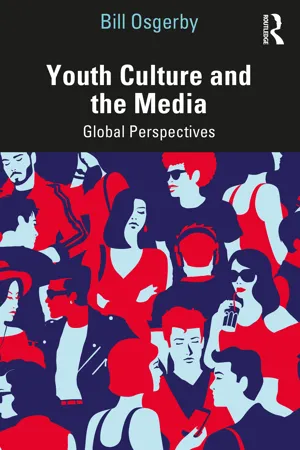This is their age – the age of the teeny-bopper and the long hair, of the Peace Corps worker and the peace marcher, of the mod and the mini, of the under 25er.
More recent ‘youthquakes’ have also registered on the Richter scale of worldwide change. In 2003, for instance, the term was emblazoned across the cover of Egypt Today, as the English-language Egyptian magazine spotlighted the way the nation’s youngsters were ‘rocking the world of movies, music and TV’ (November 2003). And in 2018 US futurologist Rocky Scopelliti used the term ‘youthquake’ for the title of his account of the way a new industrial era was being globally forged through a confluence of demographic change and technological development. For Scopelliti, the world’s growing youth population was at the cutting edge of the technological advancements transforming every facet of social life – a position, Scopelliti argued, made explicit by young people’s immersion in the realms of digital media and communications:
… their voice and influence is global through the social media they continue to fuel. It’s instantly delivered to their smartphones, and that’s become as natural to them as the air they breathe, efficiently consumed through the artificially intelligent, personalised, platform-based, exponential models serving them.
(2018: 6)
Scopelliti’s views exemplify the way youth have invariably been configured as the vanguard of technological change and, especially, the emergence of new forms of media and communications. And, undoubtedly, young people have played a key role in the proliferation of digital media in the early twenty-first century. Most obviously, youth has been a key market for the new forms of communication and entertainment unleashed by digital technologies, but young people have also been in the forefront of the way these technologies are used for new forms of cultural expression and self-representation. Symbolic configurations of youth, moreover, have invariably figured in the way the media itself has interpreted these changes, with young people represented as both the epitome of the social benefits afforded by technological innovation, and the embodiment of their malignant consequences. These relationships between youth and the media, however, are not unique to the age of digital communication. As this book demonstrates, throughout the twentieth and early twenty-first centuries, close connections have existed between developments in youth culture and changes in the fields of media and communication.
Primarily, this book explores the complex relationships that exist in the production, circulation, and consumption of media and cultural texts geared towards markets and audiences of young people. It analyses the historical development and contemporary configuration of the commercial youth market, highlighting its relation to both the broader development of modern media institutions and to wider shifts in social, economic, and political relations. Attention is given to the impact of increasing conglomeration in the media industries, the shift towards niche marketing and the growing importance of ‘cultural intermediaries’ in modern business practice. But consideration is also given to youth’s relationship with the media and the various ways young people make commercial texts and products ‘meaningful’. Recognition is given to young people’s ability to be ‘active consumers’ who create their own identities through their practices of consumption, but issues of institutional power, control, and inequality are also stressed. Generally, emphasis is placed on the way cultural meanings are always dynamic – continually formed and reformed as they circulate through (and feed back into) the various sites of production, representation, and consumption.
As well as exploring the symbiotic relationships that exist between young people’s cultural formations and commercial industries, this book also analyses media representations of young people and the way configurations of ‘youth’ have featured within wider media and political discourse. Here, attention is given to the various ways the media have constructed ‘ideologies of youth’ through the deployment of specific representational codes and modes of address. The constitution of ideologically-charged representations of youth, it is argued, has functioned as an important medium through which fundamental shifts in social boundaries and cultural relationships have been historically explored, made sense of and interpreted – not only by the media, but also by legislators, institutions of social control and a wide spectrum of cultural commentators.
The book also seeks to place these issues within a ‘global’ context. In a world characterised by growing social, economic, and political connections, local youth cultures cannot be understood in isolation but only as part of an international web of connections, exchanges, and experiences. As David Buckingham and Mary Jane Kehily explain, the early twenty-first century has seen many young people’s lives transformed by the forces of globalisation:
Young people are now growing up with significantly greater access to globalized media: media companies are increasingly constructing and targeting global markets, and young people are using new media to form and sustain transnational connections. Growing numbers of them have also experienced global migration, and inhabit communities in which a wide range of global cultures mix and cross-fertilize.
(Buckingham and Kehily, 2014: 8–9)
The flows of globalisation, however, have not subsumed differences between the experiences and expressions of young people around the world. Indeed, rather than speaking of youth culture (singular), it is probably more accurate to think in terms of youth cultures (plural), and this book highlights the way local histories and circumstances still play a crucial role in defining and determining young people’s lives. At the same time, however, local experiences are embedded in international networks of interaction and influence, and so this book stresses the way global perspectives are essential for understanding the relationships between youth culture(s) and the media.
